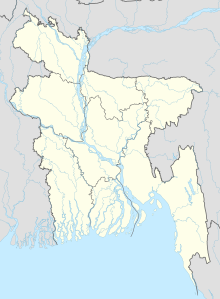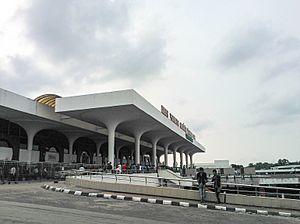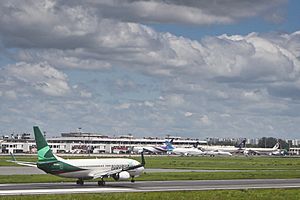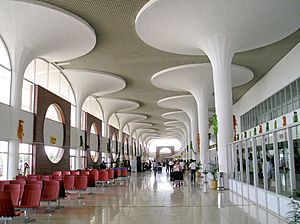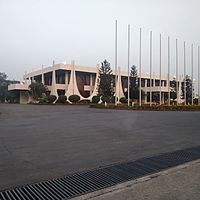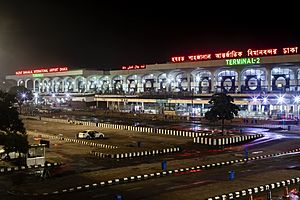Hazrat Shahjalal International Airport facts for kids
Quick facts for kids
Hazrat Shahjalal
International Airport হযরত শাহ্জালাল আন্তর্জাতিক বিমানবন্দর
|
|||||||||||
|---|---|---|---|---|---|---|---|---|---|---|---|
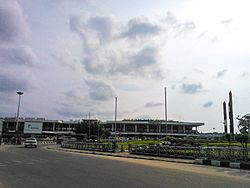 |
|||||||||||
| Summary | |||||||||||
| Airport type | Public / Military | ||||||||||
| Owner | Ministry of Civil Aviation and Tourism | ||||||||||
| Operator | Civil Aviation Authority, Bangladesh (CAAB) | ||||||||||
| Serves | Dhaka Division | ||||||||||
| Location | Kurmitola, Dhaka, Bangladesh | ||||||||||
| Opened | 1981 | ||||||||||
| Hub for |
|
||||||||||
| Elevation AMSL | 27 ft / 8 m | ||||||||||
| Coordinates | 23°50′34″N 090°24′02″E / 23.84278°N 90.40056°E | ||||||||||
| Map | |||||||||||
| Runway | |||||||||||
|
|||||||||||
| Statistics (2019) | |||||||||||
|
|||||||||||
|
Source: Civil Aviation Authority, Bangladesh
|
|||||||||||
Hazrat Shahjalal International Airport is the main airport for Dhaka, the capital city of Bangladesh. It is also the biggest airport in Bangladesh. You can find it in Kurmitola, about 17 kilometres (11 mi) north of the city center. The airport is also used by the Bangladesh Air Force.
This airport covers a large area of 802 hectares (1,981 acres). The Civil Aviation Authority of Bangladesh (CAAB) runs and looks after the airport. It started working in 1980, taking over from Tejgaon Airport as the country's main international airport.
The airport has had a few names. It was first called Dacca International Airport. Later, it became Zia International Airport. Finally, it was named Hazrat Shahjalal International Airport to honor Shah Jalal. He was a very respected Sufi saint in Bangladesh. The airport's code, "DAC", comes from "Dacca", which was the old way to spell "Dhaka".
This airport is the main base for most airlines in Bangladesh. These include Air Astra, Novoair, US-Bangla Airlines, and the national airline, Biman Bangladesh Airlines. The airport can handle about 18.5 million passengers each year. Experts believe this is enough until 2026. In 2014, it served 9.1 million passengers and moved 248,000 tonnes of cargo. About 190 flights take off or land here every day.
Biman Ground Handling helps with aircraft on the ground. This company is part of Biman Bangladesh Airlines. The airport has Wi-Fi Internet everywhere. All terminals have special lounges for First Class and Business Class travelers. Some of these lounges are run by fancy hotels or banks. If you have a Priority Pass card, you can also get into some lounges for free.
Contents
Getting to the Airport
The airport is in Kurmitola, about 11 nautical miles (20.37 kilometres; 12.66 miles) north of downtown Dhaka. You can get there using the eight-lane Airport Road. The Uttara area and Gazipur city are to the north. Dhaka city is to the south.
Right outside the airport, there is a train station called Airport Railway Station. Many ride-sharing apps like Obhai, Pathao, Shohoz, and Uber can take you to and from the airport. There is also a taxi stand where you can book and pay for a taxi.
The closest hotels to the airport are the Radisson Blu Dhaka Water Garden Hotel, Le Méridien Dhaka Hotel, and the Dhaka Regency Hotel. A Best Western hotel also opened nearby in 2014. The city has grown a lot around the airport. This has led to plans for a third terminal and possibly another international airport in the Dhaka area.
Airport History
In 1941, during Second World War, the British government built a landing strip in Kurmitola. This was a backup for Tejgaon Airport, which was a military airport at the time. It helped warplanes fly to places like Kohima and Burma.
After Pakistan was created in 1947, Tejgaon Airport became the first civilian airport in what was then East Pakistan (now Bangladesh). During the 1965 Indo-Pakistani war, the old airstrip was bombed by mistake.
In 1966, the Pakistan Government decided to build a new airport. They chose the current spot north of Kurmitola. French experts helped design the terminal and runway. A train station was also built nearby to bring in building materials. However, the new airstrip was not finished when the Bangladesh Liberation War started in 1971. The airstrip was badly damaged during the war.
After Bangladesh became independent, its government continued the work. They decided to make this airport the country's main international airport. A French company, Aéroports de Paris, became the new consultants. The airport officially opened in 1980. The main runway and part of the terminal were opened by the President of Bangladesh, Ziaur Rahman. It was called Dacca International Airport.
The project took three more years to finish. In 1983, President Abdus Sattar reopened the airport as Zia International Airport.
In 1993, Biman Bangladesh Airlines started flights to New York City. In 2010, the government changed the airport's name again. It became Hazrat Shahjalal International Airport to honor the Sufi saint Shah Jalal.
On December 6, 2011, a Boeing 787-9 plane stopped at the airport. It was trying to set a world record for distance and speed. This plane flew 10,710 nautical miles (19,830 km) non-stop from Seattle to Dhaka. This set a new distance record for its type of aircraft. The plane then flew back to Seattle, setting a world-circling speed record of 42 hours and 27 minutes.
In July 2022, Biman started flights to Toronto.
Airport Upgrades
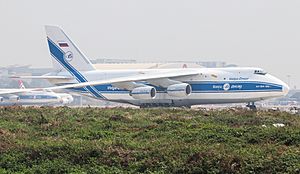
In 1992, the airport terminal grew quickly. It added more boarding bridges and equipment. A multi-story car park for 500 cars was also built.
The CAAB has spent a lot of money to upgrade the airport's technology. This includes systems like the instrument landing system and distance measuring equipment. These help the airport run better. Two more boarding bridges are now in use, and another is being made.
Work on the asphalt runway started in December 2012 and took six months. More improvements to the taxiway and runway lighting will be made with money from Denmark. Other plans include new radar systems, a new control tower, and a modern drainage system.
Parking areas for both passenger and cargo planes are being improved. This will allow four large passenger planes and two large cargo planes to park at the same time. In recent years, the CAAB has also made the terminal buildings look nicer. They added more check-in and immigration counters and baggage belts.
The inside of the terminals, like concourses and toilets, have also been updated. The duty-free shops now sell international luxury brands. As part of these improvements, the first international coffee shop, Barista Lavazza, opened in 2014. Krispy Kreme followed in 2017.
Third Terminal Development
On December 28, 2019, the Prime Minister, Sheikh Hasina, started the work for the third terminal. The Aviation Dhaka Consortium (ADC) is building it. This group includes Mitsubishi Corporation, Fujita Corporation, and Samsung C&T Corporation.
The new third terminal is expected to be finished by 2024. The Japan International Cooperation Agency (JICA) is helping to pay for some of the work. The expansion will include a large passenger terminal, a special VVIP area, a cargo building, and a multi-level car park with a tunnel.
Once the third terminal is ready, the airport will be able to handle 20 million passengers each year. This is a big jump from the current 8 million. The cargo handling capacity will also increase from 200,000 to 500,000 tonnes annually.
Airport Terminals
Terminal 1, Terminal 2, and Domestic Terminal
The airport has three main terminals. Terminal 1 (T1) and Terminal 2 (T2) are for international flights. They are in the same building. T1 is on the ground floor for international arrivals. T2 is on the upper floor for international departures.
There is also a separate building for domestic flights, called the Domestic Terminal. It is next to the international terminals. In this one-story building, both arrivals and departures are on the same floor.
Terminal 3
A third international terminal is being built and should open in 2024. This new terminal will have 26 boarding bridges and 12 conveyor belts for luggage. It will also have 115 check-in counters and 59 immigration desks.
VIP Terminal
A special VIP terminal building is located to the right of the international terminals. It is only about 200 metres (220 yards) from the main gate.
Cargo Terminal
The airport has a cargo terminal that can handle 200,000 tons of goods each year. After the current renovation and expansion, it will be able to handle 500,000 tons.
Airlines and Destinations
Passenger Flights
| Airlines | Destinations | Refs |
|---|---|---|
| Air Arabia | Abu Dhabi, Ras Al Khaimah, Sharjah | |
| AirAsia | Kuala Lumpur–International | |
| Air Astra | Chittagong, Cox's Bazar, Sylhet | |
| Air India | Delhi (resumes 15 September 2023), Kolkata | |
| Air Premia | Charter: Seoul–Incheon | |
| Batik Air Malaysia | Kuala Lumpur–International | |
| Biman Bangladesh Airlines | Abu Dhabi, Bangkok–Suvarnabhumi, Barisal, Chittagong, Cox's Bazar, Dammam, Delhi, Doha, Dubai–International, Guangzhou, Hong Kong, Jeddah, Jessore, Kathmandu, Kolkata, Kuala Lumpur–International, Kuwait, London–Heathrow, Manchester, Medina, Muscat, Rajshahi, Riyadh, Saidpur, Sharjah, Singapore, Sylhet, Tokyo–Narita (resumes 1 September 2023), Toronto–Pearson, Yangon | |
| Cathay Pacific | Hong Kong | |
| China Eastern Airlines | Beijing–Daxing, Kunming | |
| China Southern Airlines | Guangzhou | |
| Drukair | Bangkok–Suvarnabhumi, Paro | |
| Egyptair | Cairo | |
| Emirates | Dubai–International | |
| Etihad Airways | Abu Dhabi | |
| Flydubai | Dubai–International | |
| Gulf Air | Bahrain | |
| Himalaya Airlines | Kathmandu | |
| IndiGo | Chennai, Delhi, Kolkata, Hyderabad, Mumbai | |
| Iraqi Airways | Baghdad | |
| Jazeera Airways | Kuwait | |
| Jin Air | Charter: Seoul-Incheon | |
| Kuwait Airways | Kuwait | |
| Malaysia Airlines | Kuala Lumpur–International | |
| Maldivian | Malé | |
| Novoair | Chittagong, Cox's Bazar, Jessore, Kolkata, Rajshahi, Saidpur, Sylhet | |
| Oman Air | Muscat | |
| Qatar Airways | Doha | |
| Salam Air | Muscat | |
| Saudia | Dammam, Jeddah, Medina, Riyadh | |
| Singapore Airlines | Singapore | |
| SriLankan Airlines | Colombo–Bandaranaike | |
| Thai AirAsia | Bangkok–Don Mueang | |
| Thai Airways International | Bangkok–Suvarnabhumi | |
| Thai Lion Air | Bangkok–Don Mueang | |
| Turkish Airlines | Istanbul | |
| US-Bangla Airlines | Bangkok–Suvarnabhumi, Barisal, Chennai, Chittagong, Cox's Bazar, Doha, Dubai–International, Guangzhou, Jessore, Kolkata, Kuala Lumpur–International, Malé, Muscat, Rajshahi, Saidpur, Sharjah, Singapore, Sylhet | |
| Vistara | Delhi, Mumbai |
: Biman Bangladesh Airlines's flight from Dhaka to Toronto and vice versa makes a technical stop at Istanbul for refueling and crew change. Biman Bangladesh does not carry passengers solely from Dhaka to Istanbul, nor does the airline have fifth freedom rights to fly passengers from Istanbul to Toronto.
Cargo Flights
| Airlines | Destinations | Refs. |
|---|---|---|
| Air Bridge Cargo | Krasnoyarsk, Shanghai-Pudong | |
| Cathay Cargo | Hanoi, Hong Kong | |
| China Cargo Airlines | Shanghai-Pudong, Zhengzhou | |
| Easy Fly Express | Delhi, Guangzhou, Hong Kong, Kolkata, Zhengzhou | |
| Ethiopian Airlines Cargo | Addis Ababa | |
| Etihad Cargo | Abu Dhabi, Hanoi | |
| Hong Kong Airlines Cargo | Hong Kong | |
| Qatar Airways Cargo | Doha | |
| Saudia Cargo | Dammam, Jeddah, Riyadh | |
| Silk Way Airlines | Baku | |
| SkyAir | Chittagong, Cox's Bazar, Jessore, Sylhet | |
| Sky Gates Airlines | Baku | |
| Singapore Airlines Cargo | Amsterdam, Sharjah, Singapore | |
| Turkish Airlines Cargo | Almaty, Ashgabat, Istanbul-Atatürk |
Past Events at the Airport
- On September 28, 1977, a Japan Airlines flight was taken over by five terrorists. They made the plane land at the airport (then called Zia International Airport). The Japanese Prime Minister agreed to their demands. The Bangladesh Air Force helped manage the situation.
- On August 5, 1984, a Biman Bangladesh Airlines flight from Chittagong crashed near the airport. All 45 passengers and 4 crew members on the plane died. This was a very sad event for aviation in Bangladesh.
See also
 In Spanish: Aeropuerto Internacional de Daca-Hazrat Shahjalal para niños
In Spanish: Aeropuerto Internacional de Daca-Hazrat Shahjalal para niños


